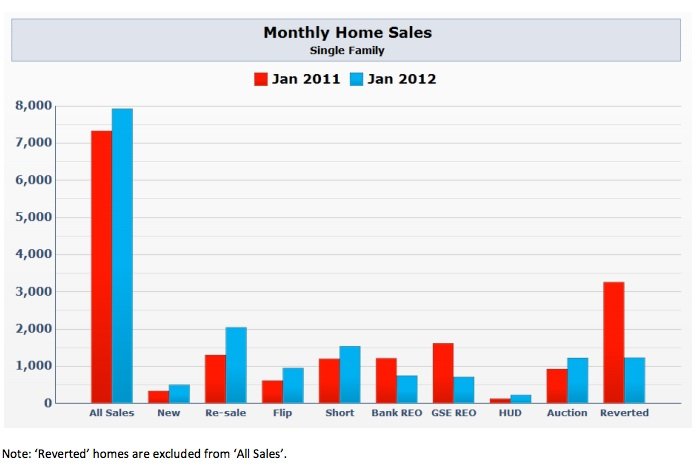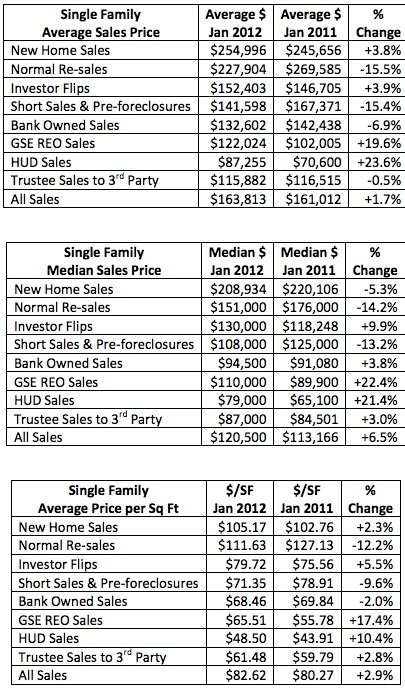Good news…we are seeing prices moving up rapidly across much of the lower price ranges in our market while mid range prices are seeing a fair amount of stabilization.
Bad news…the strong upward moving pricing is due to many months of a declining supply and increasing demand. This all bodes well for pricing and things look like they are well on their way to housing market recovery locally in Arizona.

I thought when one of my clients last month was outbid in a multiple offer situation with a total of 14 offers, that was a lot…then more recently, I received a denial letter on another offer made for a home which was a low priced foreclosure, on the market for a 5 days…in which the listing agent said he received a total of THIRTY-FOUR offers. Insane. This is the new world we live in for Phoenix real estate. We no longer have a “glut” of foreclosed homes where buyers can leisurely stroll through neighborhoods and pick up handfuls of houses with little competition.
Contract ratio and months supply are good gauges of supply/demand levels. To illustrate this point here’s some numbers from a recent study on a neighborhood I completed for a client.
- 3 homes currently available for sale
- 19 homes up for sale under contract with offers in place
- 11 homes sold in the last 3 months
That tells us on average there are about 3 homes being bought each month for this area, and with only 3 homes available that’s a one month supply! A balanced market with average months supply is supposed to be 4-6 months. Looking at contract ratio we compare number of homes for sale with number of homes on the market and under contract…with that we see 6 homes under contract for every one home available for sale…crazy!
The shadow inventory which some have worried about over the last year never came, and any small amount of supply for distressed properties that does remain will have little to no impact on values since we are well in to extreme shortage levels of homes. As mentioned in previous posts here, the distressed property pipeline was never much of a mystery as the conspiracy theorists made it out to be. When you look at the % declines in loan delinquencies, homes in the process of foreclosure, and the number of foreclosures being completed, all the writing has been on the wall for months now.
Arizona stands to put the whole foreclosure mess behind us at a much faster pace than the nation as a whole and start seeing some strong appreciation in home values…we are already seeing that. We are seeing a hard to believe 10% rise in values for many homes originally priced at $200,000 or lower fall of last year. Last September is looking like the low point, with a home that would have been sold for $150,000 now easily going for $160,000-$165,000. People worry about appraisals holding back prices from appreciating, but with 40% of all home purchases being cash there’s no appraisal necessary and the market will move how it wants to move.
When you consider the potential of future demand for people to buy homes as: rent values continue to increase, the economy and consumer confidence improve, people who lost homes to short sales and foreclosures begin to qualify for mortgages again, and the mortgage industry loosening up underwriting requirements…coupled with a continued drop in foreclosures and distressed property supply…this could be just the beginning of a strong momentum in prices.
Here’s a thorough and detailed report through the end of January 2012 as produced by The Information Market and ASU’s Center for Real Estate Theory and Practice:
MONTHLY REPORT – GREATER PHOENIX HOUSING MARKET – JANUARY
2012 Headlines:
- Overall single family home prices were 3% higher than 12 months ago (measured in $/sq ft)
- Townhouse/condo prices were down 2% compared with 12 months ago (measured in $/sq ft)
- Average and median prices have moved upwards since reaching their low point in September
- Single family median sales price is up from $113,166 to $120,500 since January 2011
- Townhouse/condo median sales price is up from $66,500 to $70,000 since January 2011
- Supply is down 42% compared with 12 months ago
- Monthly foreclosure starts were 3,710, down 49% from 7,207 in January 2011
- Monthly trustee sales totaled 2,802 are were down 42% compared with 4,813 in January 2011
- There has been a 62% reduction in the number of homes reverting to lenders at trustee sale
- Overall sales were 8% higher than in January 2011.
- Single family home sales increased for
- New homes (up 49%)
- Normal re-sales (up 57%)
- Investor flips (up 55%)
- Shorts sales and pre-foreclosures (up 28%)
- HUD sales (up 79%)
- Third party purchases at trustee sale (up 32%)
- Single family home sales reduced for:
- Bank owned homes (down 39%…largely due to huge drop in foreclosures supply)
- GSE (Fannie Mae, Freddie Mac, etc.) owned homes (down 56%)
Unless otherwise stated all the statistics shown are for Maricopa and Pinal Counties combined.
Introduction
Our normal seasonal pattern calls for a busy December followed by a quiet January before the peak buying season starts in earnest during February. This year is no exception. Because of these strong seasonal patterns it is more useful to compare data for a calendar month to the same month in prior years, rather than the immediately preceding month. The sections below compare January 2012 data for Maricopa and Pinal County with that for January 2011. Because foreclosures and short sales continue to exert a very strong influence on the market we have analyzed volumes and pricing for 8 different transaction types as well as for the overall totals. Individual statistics are also provided in the attached tables by county and by city.
Demand
Single family home sales rose 8.1% compared with January 2011, with Maricopa County up 10.3% to 7,033 while Pinal County was down 6.0% to 893. Townhouse/condo sales increased 1.7% to 1,219, almost all in Maricopa County. However these numbers hide more dramatic changes in the types of sales taking place. In January 2011 the majority (78%) of trustee auctions received no bid and the property reverted to the foreclosing lender. In January 2012, bidding at these auctions has become far more competitive and 50% of the properties are now going to third party bidders. This means far fewer foreclosed homes have been added to the REO inventory of banks and GSE lenders. As a result of the lower inventory, subsequent sales by these organizations have also declined over the last 12 months.
These changes are illustrated in the bar chart below:

According to the STAT report from our local Multiple Listing Service (ARMLS Inc), there were 25,025 active listings in January. This is down 42% from the 42,881 we saw a year ago. This is a significant drop in supply and the inventory of homes for sales is now well below the average for the last 10 years. Supply is heavily weighted towards the higher priced end of the market where there are still an abundance of homes available. As we move down the price ranges the inventory of homes for sale drops off dramatically, particularly for those priced below $300,000. The supply of distressed homes (short sales and lender owned homes) through ARMLS is down 78% while normal supply is down by only 24%.
Pricing
We can see that overall prices reached a low point in August and September 2011 and have risen since then. However the picture is far more complex than that suggests. When we look at the individual transaction types we find the following:
Single Family Average Sales Price
Note that prices moved higher to a greater extent in Pinal County than in Maricopa, but Maricopa sales dominate by a ratio of approximately 8 to 1, so the overall effect is more muted. REO sales declined faster in Pinal while Short sales and pre-foreclosures grew faster.
Outlook
After a slump during the third quarter of 2011, the Phoenix residential market has improved significantly and a recovery is now well under way. How fast this recovery develops is still uncertain but a number of factors are improving rather than deteriorating. Supply is tight, interest rates are extremely low, the economy is showing some signs of life and prices are still very affordable compared with salaries and rental rates. Public sentiment toward housing remains very poor but is starting to improve. Loans are still very hard to come by but any change appears to be in the direction of easier underwriting rather than making loans even more unattainable by the regular home-buyer.
With prices that have declined more than almost anywhere in the US except Nevada, we have a large number of homeowners with loans that exceed the market value of their home. Following HARP 2.0 and the recent settlement between the states and five large lenders, these homeowners have more of an opportunity to refinance into low interest loans. This will not solve their underwater condition, but it will probably reduce their monthly payments and allow them to feel less financial stress.
Given that wholesale reductions in loan principles appear unlikely, the main mechanism to solve underwater loan problems is for prices to rise. Overall prices have indeed improved a little since September and are currently on a strong upward trend. However that trend is dominated by lender owned properties and flips. Normal re-sales and short sales have yet to participate in the improving price movement. It will take very many months of strong improvement for the negative equity problem to abate, and there is little chance of pricing achieving the heights of 2006 in the medium term or indeed the next decade. However a supply/demand situation now exists that allows for the possibility of a significant rise in pricing at the lower end of the market in the immediate future. We will have to wait and see if this possibility turns into reality.
Foreclosure Starts
New notices of trustee sale have fallen by 48.5% since January last year, to 3,298 for Maricopa and 412 for Pinal (for single family and townhouse/condo combined). However there was little change between December 2011 and January 2012. Our worst month ever for new notices was March 2009 and we are now down 67% from that peak level. For comparison with “normal” levels of foreclosure notices, in 2002 we averaged 1,160 per month for Maricopa County. Since the population has grown by about 20% since 2002, we would consider 1,400 foreclosure starts per month a normal level for Maricopa County, so we are still at slightly more than double the normal level. A normal level for Pinal County is harder to estimate because the population in Pinal County has more than doubled in the last 10 years.
Foreclosure Completions
We can see a dramatic change in foreclosure results when we compare January 2012 with January 2011.
- The number of completed trustee sales is down by 42%
- The number of homes reverting to lenders is down by 62%
The number of homes purchased by third parties at the auction is up by 32%So the supply of REOs has been severely reduced while the number of homes being purchased by third parties at auction is at unprecedentedly high levels for the time of year. In January 2012 almost as many homes were being purchased at the auction as were going back to the lenders and we see the growth in third party share increasing over the coming months. This time last year there were 3.6 homes going back to the lender for each one purchased by a third party.New Home Sales
Recorded new single family home sales increased by 49% from the very low level of 333 in January 2011 to 496 in January 2012. At 59%, Maricopa County growth was much stronger than Pinal at 8% and new sales were concentrated in Gilbert (130 homes), Phoenix (50), Chandler (49) and Goodyear (43). Average prices and average $/SF increased although the median sales price fell. Developers are anticipating a mild recovery in 2012 from their worst ever year for sales volume in 2011. New home sales currently represent only 6% of the market, but at least this is up from 5% in January 2011.
Normal Re-sales
Normal owner-occupier single family re-sales jumped from 1,302 in January 2011 to 2,042 in January 2012. This increase of 57% was accompanied by a significant reduction in average price per sq. ft. from $127.13 to $111.63. The median sales price fell 14% from $176,000 to $151,000. The negative price trend for normal sales is exaggerated by a quiet luxury market which is currently out of balance with an extremely active market for homes below $300,000.
Investor Flips
These are similar to normal re-sales in that there is no distressed owner, but we count separately those sales where the property was previously purchased within the last 6 months. Often the investor obtained a distressed property at a trustee sale (sometimes through a wholesaler), as an REO or, more rarely, as a short sale. The investor usually refurbishes and renovates the property and then sells the home somewhat below the price for normal sales in order to ensure it sells quickly. Prices for investor flips have moved in the opposite direction to normal sales, with average $/SF increasing by 5.5% between January 2011 and January 2012. Investor flips have grown 55% in both Maricopa and Pinal Counties over the last year and now represent about 12% of total sales, up from 8% in January 2011.
Short Sales and Pre-foreclosures
Lenders have looked more favorably at short sales over the last year as the best means of terminating an underwater loan situation where the borrower is no longer able or willing to make the monthly payments. Consequently we have seen short sales volumes grow by 26% in Maricopa and 45% in Pinal. As lenders approve more offers, pricing for short sales has declined from $78.91 to $71.35 per sq. ft. over the last 12 months. Short sales and pre-foreclosures represent about 19% of total sales, up from 16% in January 2011.
Bank Owned Sales
Often referred to as REO sales, these are properties owned by commercial lenders following a completed foreclosure. If there are no bidders at the trustee sale the trustee issues a deed in favor of the beneficiary, i.e. the foreclosing lender who subsequently liquidates the asset by marketing the property as a “banked owned home”. Between January 2011 and January 2012 these REOs have declined sharply in volume, with Pinal County down 58% and Maricopa County down a more modest 36%. Sales $/SF pricing for bank owned REOs is up 23% in Pinal County but down 7% in Maricopa over the last 12 months. Maricopa County’s $/SF decline is partly due to there being fewer luxury homes in the REO sales mix in January 2012. Bank owned REOs represent 9% of the market, down from 17% in January 2011.
Fannie Mae / Freddie Mac / VA Sales
Similar to Bank Owned Sales except the entity receiving the foreclosed home is a government sponsored enterprise (GSE) rather than a commercial lender. Between January 2011 and January 2012 these REOs have declined very significantly in volume, with Pinal County down 65% and Maricopa County down 54%. Sales $/SF pricing for GSE REOs is up 17% in Pinal County and up 16% in Maricopa over the last 12 months. GSE REOs represent 9% of the market, down from 22% in January 2011.
HUD sales
If a bank receives a property through foreclosure where the loan had been insured by FHA, the lender will usually deed the property to HUD for disposal. These are generally the cheapest homes available in any area although they are not usually numerous. HUD changed their management company during 4Q
2010 so January 2011 was an artificially light sales month for HUD. HUD sales peaked during the second quarter of 2011 and have been in decline since. Prices have increased an average of 10.4% over the last 12 months, but at $48.50 remain much lower than other sources.
Third Party Purchases from Trustee Sales
Although trustee sales have declined since peaking in March 2010, foreclosures still provide a significant supply of homes for those willing to bid at the trustee auction. During January 2012, there were 1,222 single family and townhouse/condos purchased by third parties in this way, 1,112 in Maricopa and 110 in Pinal. Average prices have risen from $59.79 to $61.48 per sq. ft. for these homes over the last 12 months. They represent 15% of the market, up from 13% in January 2011.
Reverted to Lender (i.e. Beneficiary)
If the lender sets an opening bid which is too high to attract any bids then the property fails to sell and it becomes the lender’s property to dispose of. The outstanding loan debt is removed with no recourse (under Arizona law) to the original borrower. Most other liens (but not necessarily all) are also eliminated at this time. When the lender is not interested in disposing of the property through the trustee sale, the opening bid is often set to be the outstanding loan balance plus expenses, so this will usually be well in excess of the current market value. As such the bid has little to no relevance to us and we do not record it as a sale. However if the lender wishes to liquidate the home at the trustee sale, an opening bid is set which is low enough to attract the interest of third parties. Over the last 12 months, more opening bids have been set at reasonable levels and combined with increased investor demand the number of reversions to beneficiaries has dropped sharply. There were 3,258 in January 2011 and only 1,227 in January 2012. The fall was even larger in Pinal (69%) than in Maricopa (61%).
Out of State Purchasers
The percentage of residences in Maricopa County sold to owners from outside Arizona reduced slightly between January 2011 and January 2012. It fell from 26.0% to 25.2% by unit count and from 29.7% to 28.1% by dollar value.
Cash Buyers
Cash purchases are running at an abnormally high level due to strict underwriting guidelines imposed by lenders. Nevertheless in Maricopa County in January 2012 the percentage of properties purchased without a loan fell slightly from 40.9% to 39.9% by unit count and from 34.4% to 32.4% by dollar value, when compared with January 2011.
Landlord Purchases
When someone purchases real property in Arizona, an Affidavit of Value is usually recorded by the county. The new owner indicates whether the property will be occupied by the owner or a “family member”, or instead will be rented to someone other than a “family member”. Studying this information gives us some idea how many homes are being acquired by landlords. The data for January 2011 and January 2012 are as follows:
These percentages are much higher than the historical norm (about 10%) and indicate that investors are extremely active acquiring homes to rent to people who have lost their former homes to foreclosure or through a short sale. There has been little change over the last 12 months.
Source & Acknowledgement
The sales and foreclosure transaction data used in this report was compiled by the Information Market , LLC of Glendale AZ (www.theinformationmarket.com) and ASU Center for Real Estate Theory and Practice.



